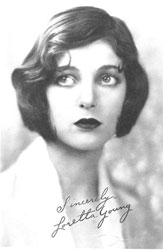Becoming Loretta
 By 1929, at age 16, Loretta was carving out a place in the industry, doing five or six pictures a year and earning $250 a week at a time when the Great Depression loomed, and the average family income was about $50 per month.
By 1929, at age 16, Loretta was carving out a place in the industry, doing five or six pictures a year and earning $250 a week at a time when the Great Depression loomed, and the average family income was about $50 per month.
When she wasn't in front of the camera, she watched other actresses work, learning about hair, clothes and makeup. It was an era of great change in the picture business, since new technology had finally brought about the "talkies."
Many stars who had succeeded in silent pictures discovered that their voices could not make the transition to sound films. And for a time, it looked as if Loretta would fall into that category.
 The directors of First National Studios, where she worked, thought her voice was too low to sound feminine on film. But the studio president, A1 Rockett, disagreed.
The directors of First National Studios, where she worked, thought her voice was too low to sound feminine on film. But the studio president, A1 Rockett, disagreed.
He put Loretta in the very first "talkie" that First National ever made, The Squall. The film was shot at night to minimize background noise, since the Hollywood soundproof stage had yet to be invented.
"Myrna Loy played the part of the gypsy, an she was fascinating," Loretta said. "I was the ingenue, and I was boring." Whether boring or not, her voice had passed the test.
Loretta found that work as an actress involved incredibly long hours. This was before the days of labor unions or protection for minors, and "even though being an actress meant years of getting up at 5 in the morning, it was never natural for me," Loretta, a late-riser, recalled. "They used to save all my close-ups until late in the afternoon, when my face finally came to life."
Now, as Loretta's career evolved, so did her self-imposed perfectionism. Every seam on a dress, every line of dialogue, every lift of her lashes had to be, not merely acceptable, but flawless. She practiced endlessly, memorizing complete scenes in order to compensate for her dyslexia, which she'd had since childhood.
 Remarkably, although her two older sisters were in the same business and competing for many of the same parts, there was not much professional rivalry between the three Young sisters. Loretta was under contract and worked more frequently and was earning the largest salary. Sally was also busy, but bounced from one studio to another.
Remarkably, although her two older sisters were in the same business and competing for many of the same parts, there was not much professional rivalry between the three Young sisters. Loretta was under contract and worked more frequently and was earning the largest salary. Sally was also busy, but bounced from one studio to another.
At home, the girls still shared a communal wardrobe, and the first one out in the morning was the best dressed. They all tossed their salaries in a common pot, and Gladys gave them money if and when they needed it.
Despite Loretta's gathering success, Sally and Polly still regarded their younger sister as an occasional pain, giving her the nickname; "Gretch the Wretch."
Next: Grant Withers
Excerpts © copyright 2000 Joan Wester Anderson. All rights reserved.